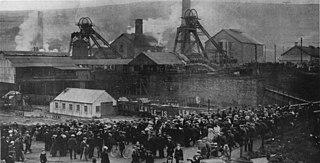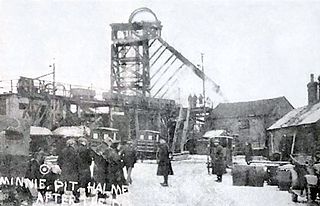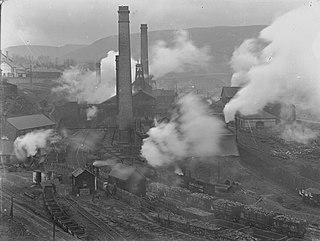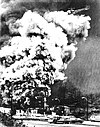Related Research Articles
A mining accident is an accident that occurs during the process of mining minerals or metals. Thousands of miners die from mining accidents each year, especially from underground coal mining, although accidents also occur in hard rock mining. Coal mining is considered much more hazardous than hard rock mining due to flat-lying rock strata, generally incompetent rock, the presence of methane gas, and coal dust. Most of the deaths these days occur in developing countries, and rural parts of developed countries where safety measures are not practiced as fully. A mining disaster is an incident where there are five or more fatalities.
A safety lamp is any of several types of lamp that provides illumination in places such as coal mines where the air may carry coal dust or a build-up of inflammable gases, which may explode if ignited, possibly by an electric spark. Until the development of effective electric lamps in the early 1900s, miners used flame lamps to provide illumination. Open flame lamps could ignite flammable gases which collected in mines, causing explosions; safety lamps were developed to enclose the flame to prevent it from igniting the explosive gases. Flame safety lamps have been replaced for lighting in mining with sealed explosion-proof electric lights, but continue to be used to detect gases.

The Monongah mining disaster was a coal mine explosion on December 6, 1907, at Fairmont Coal Company's Nos. 6 and 8 mines in Monongah, West Virginia, which killed 362 miners. It has been described as "the worst mining disaster in American history" and was one of the contributing events that led to the creation of the United States Bureau of Mines.

The Senghenydd colliery disaster, also known as the Senghenydd explosion, occurred at the Universal Colliery in Senghenydd, near Caerphilly, Glamorgan, Wales, on 14 October 1913. The explosion, which killed 439 miners and a rescuer, is the worst mining accident in the United Kingdom. Universal Colliery, on the South Wales Coalfield, extracted steam coal, which was much in demand. Some of the region's coal seams contained high quantities of firedamp, a highly explosive gas consisting of methane and hydrogen.

The Courrières mine disaster, Europe's worst mining accident, caused the death of 1,099 miners in Northern France on 10 March 1906. This disaster was surpassed only by the Benxihu Colliery accident in China on 26 April 1942, which killed 1,549 miners. A coaldust explosion, the cause of which is not known with certainty, devastated a coal mine operated by the Compagnie des mines de houille de Courrières. Victims lived nearby in the villages of Méricourt, Sallaumines, Billy-Montigny, and Noyelles-sous-Lens. The mine was 2 km (1 mi) to the east of Lens, in the Pas-de-Calais département.
The Moweaqua Coal Mine disaster happened on December 24, 1932, in Moweaqua, Illinois. The disaster was caused by a methane gas explosion killing 54 miners. The explosion occurred shortly after the day shift started, sometime between 7:30 and 8:00 Christmas Eve morning.
On March 25, 1947, the Centralia No. 5 coal mine exploded near the town of Centralia, Illinois, killing 111 people. The Mine Safety and Health Administration of the United States Department of Labor reported the explosion was caused when an underburdened shot or blown-out shot ignited coal dust. The US Department of Labor lists the disaster as the second worst US mining disaster since 1940 with a total of 111 men dead.
Almy was a coal mining camp in Uinta County, Wyoming, United States, near the town of Evanston. In 1881, an explosion killed 38 miners in the Central Pacific Mine, marking the first mine explosion west of the Mississippi River. Another explosion killed 13 in 1886, and a third explosion in Red Canyon in 1895 killed 62 miners, the third worst mining disaster in Wyoming history. Following the second explosion, the Wyoming territorial legislature established the office of the state mining inspector, which eventually shut down the Almy mines in the 1940s after it was deemed too dangerous to mine there.

Castle Gate is a ghost town in the western United States, located in Carbon County in eastern Utah. A mining town approximately ninety miles (140 km) southeast of Salt Lake City, its name was derived from a rock formation near the mouth of Price Canyon. This formation features two sheer sandstone walls on either side of the Price River, which appear to open like a giant gate as travelers approach this narrow section of the canyon.

The Darr Mine disaster at Van Meter, Rostraver Township, Westmoreland County, Pennsylvania, near Smithton, killed 239 men and boys on December 19, 1907. It ranks as the worst coal mining disaster in Pennsylvanian history. Many victims were of immigrants from central Europe, including Rusyns, Hungarians, Austrians, Germans, Poles and Italians.

The Cross Mountain Mine disaster was a coal mine explosion that occurred on December 9, 1911, near the community of Briceville, Tennessee, in the southeastern United States. In spite of a well-organized rescue effort led by the newly created Bureau of Mines, 84 miners died in the disaster. The cause of the explosion was the ignition of dust and methane gas released by a roof fall. Miners would use open oil lamps to provide a light source down in the mines.

The Minnie Pit disaster was a coal mining accident that took place on 12 January 1918 in Halmer End, Staffordshire, in which 155 men and boys died. The disaster, which was caused by an explosion due to firedamp, is the worst ever recorded in the North Staffordshire Coalfield. An official investigation never established what caused the ignition of flammable gases in the pit.
Winter Quarters is a ghost town in Carbon County, Utah, United States. Coal was discovered in the area in 1875, and later that year, the Pleasant Valley Coal Company began coal mining operations. A group of coal miners was delayed during an early winter storm in 1877, which led to the town's name of Winter Quarters. On May 1, 1900, an explosion in the Winter Quarters Number Four mine killed 200 miners. Despite the mine explosion, the coal mining operations remained active until 1922, when the opening of a new mine in Castle Gate caused many people to relocate there. By 1930, Winter Quarters was abandoned.
The Scofield Mine disaster was a mining explosion that occurred at the Winter Quarters coal mine on May 1, 1900. The mine was located at 39°42′57″N111°11′17″W near the town of Scofield, Utah. In terms of life lost, it was the worst mining accident at that point in American history. The explosion is also a key element in the plot of the Carla Kelly novel My Loving Vigil Keeping.
The Kaitangata Mine disaster was one of New Zealand's early industrial disasters and the first of its kind in New Zealand. Thirty-four miners lost their lives at 8am on 21 February 1879 in an underground explosion at Kaitangata in South Otago.
The Peckfield pit disaster was a mining accident at the Peckfield Colliery in Micklefield, West Yorkshire, England, which occurred on Thursday 30 April 1896, killing 63 men and boys out of 105 who were in the pit, plus 19 out of 23 pit ponies.

The Cymmer Colliery explosion occurred in the early morning of 15 July 1856 at the Old Pit mine of the Cymmer Colliery near Porth, Wales, operated by George Insole & Son. The underground gas explosion resulted in a "sacrifice of human life to an extent unparalleled in the history of coal mining of this country" in which 114 men and boys were killed. Thirty-five widows, ninety-two children, and other dependent relatives were left with no immediate means of support.
Victor-American Fuel Company, also styled as the Victor Fuel Company, was a coal mining company, primarily focused on operations in the US states of Colorado and New Mexico during the first half of the Twentieth Century. Prior to a 1909 reorganization, the business was known as the American Fuel Company.
The 1923 Bellbird Mining Disaster took place on 1 September 1923 when there was a fire at Hetton-Bellbird coal mine, known locally as the Bellbird Colliery or mine. The coal mine was located near the village of Bellbird, which is itself three miles southwest of Cessnock in the Northern coalfields of New South Wales, Australia. The accident occurred in the No. 1 Workings of the mine and resulted in the deaths of 21 miners and their horses. At the time of the disaster the mine employed 538 people including 369 who worked underground.
References
- Costa, Janeen Arnold (1994), "Castle Gate Mine Disaster", Utah History Encyclopedia, University of Utah Press, ISBN 9780874804256, archived from the original on November 3, 2022, retrieved April 6, 2024
- Watt, Ronald G. (1997). A History of Carbon County. Utah State Historical Society. ISBN 0-913738-15-8.
